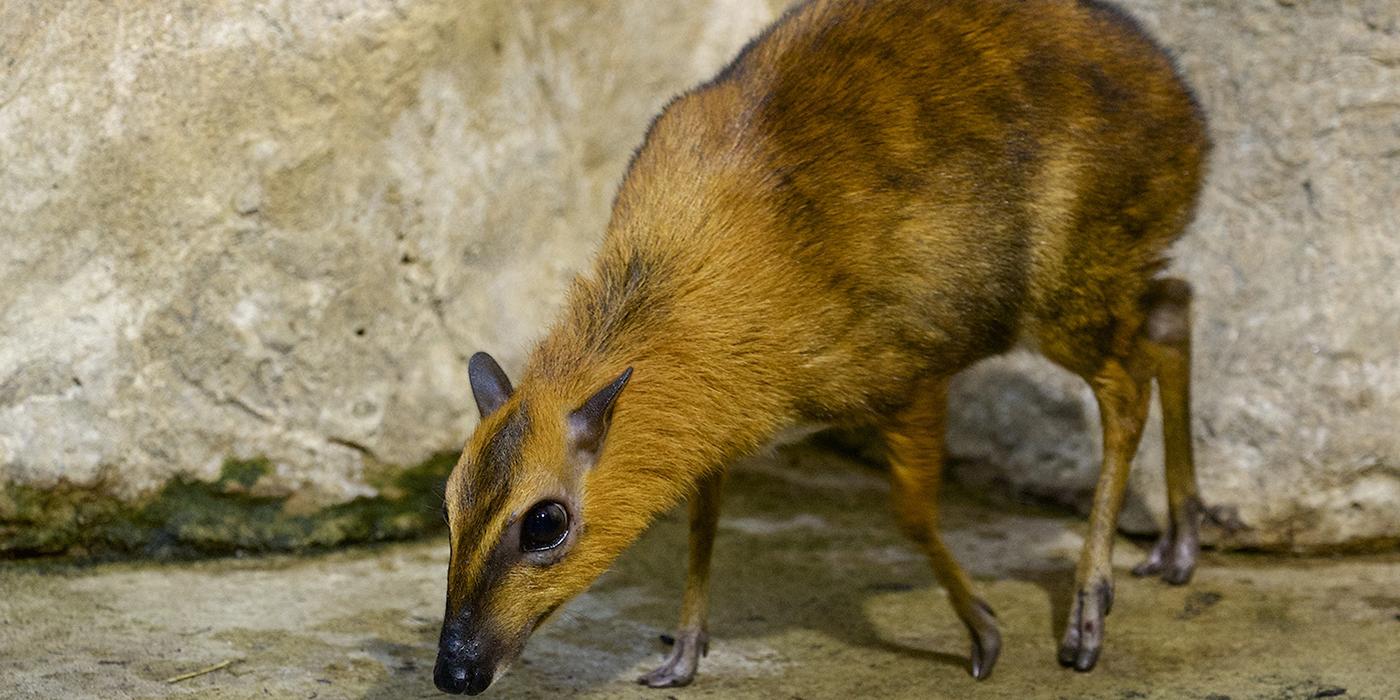Physical Description
About the size of a rabbit, these ungulates have very long and thin legs; a rounded body; and a small, triangular head with a small pointed black nose and large eyes. They are an orange-brown color with a white belly, chest and neck.
Unlike many of their relatives, they do not have horns or antlers, but males do have small tusks (elongated canines) in their upper jaw which they use in fighting. When standing on all fours, their hindquarters are taller than their front end.
Size
Larger Malay mouse-deer bodies measure about 29 inches (75 centimeter) long, with their tail adding another 3.5 inches (9 centimeter). Their shoulder height is about 13 inches (34 centimeter).
Native Habitat
Larger Malay mouse-deer live in Thailand, Indochina, Sri Lanka, and the Malayan Peninsula, as well as in Sumatra and Borneo. They always live close to water and prefer to be in the undergrowth of dense forests. They create small trails through the thick brush of the forest as they travel.
Lifespan
Larger Malay mouse-deer can live up to 16 years in human care.
Food/Eating Habits
In the wild, larger Malay mouse-deer eat a diet of fallen fruit and berries, aquatic plants, leaves, buds, shrubs and grasses. At the Smithsonian's National Zoo, larger Malay mouse-deer eat browse, alfalfa, kale, sweet potatoes, carrots, sweet potatoes and banana peels.
Social Structure
Larger Malay mouse-deer are solitary creatures, except during the breeding season. They have no strict hierarchical structure, but both sexes are territorial. Males mark their small territories with their feces, urine and secretions from the gland under their jaw. When challenged, males may beat the ground quickly with their hooves. When necessary, fights between males include short bouts of biting using their sharp canines.
Reproduction and Development
Male mouse-deer of this species have a large gland on their lower jaw that they rub against females in anticipation of mating. These animals breed year-round with a gestation period of about five months and will breed again within a couple of hours after birth. Because of this, females spend most of their adult life pregnant.
They usually have only one offspring at a time, though twin births occur rarely. The calves are well developed when born and are able to stand and be fully active 30 minutes after birth. They are weaned when they are two to three months old, and are sexually mature at 4.5 months.
Conservation Efforts
Habitat loss, forest degradation, hunting and the pet trade remain looming threats for the larger Malay mouse-deer. Many species are considered a food source for people in their native range as well. Their diminutive size has also created a demand for these animals in the pet trade.
Help this Species
- Reduce, reuse and recycle — in that order! Cut back on single-use goods, and find creative ways to reuse products at the end of their life cycle. Choose recycling over trash when possible.
- Practice ecotourism by being an advocate for the environment when you’re on vacation. During your travels, support, visit or volunteer with organizations that protect wildlife. Shop smart too! Avoid buying products made from animals, which could support poaching and the illegal wildlife trade.
- Choose your pets wisely, and do your research before bringing an animal home. Exotic animals don’t always make great pets. Many require special care and live for a long time. Tropical reptiles and small mammals are often traded internationally and may be victims of the illegal pet trade. Never release animals that have been kept as pets into the wild.
Animal News

Leaf-tailed Gecko Treated for Skin Cancer With Chemotherapy



